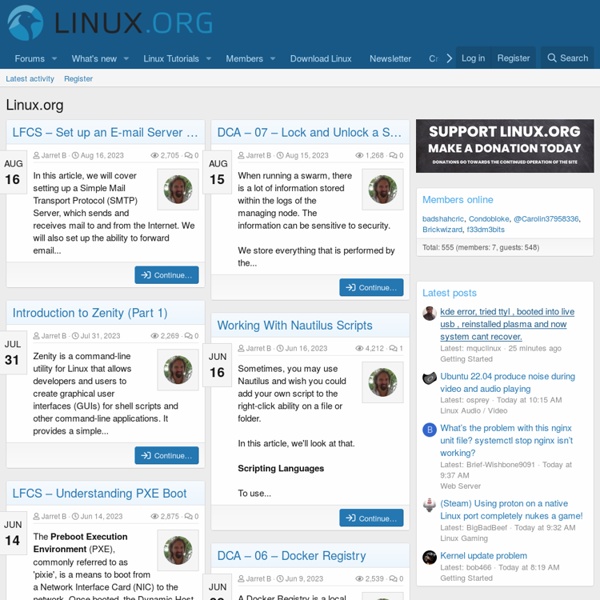



The Universal Operating System Linus Torvalds Linus Benedict Torvalds (Swedish: [ˈliːn.ɵs ˈtuːr.valds] ( Biography[edit] Early years[edit] Torvalds was born in Helsinki, Finland. He is the son of journalists Anna and Nils Torvalds,[6] and the grandson of poet Ole Torvalds. Torvalds attended the University of Helsinki between 1988 and 1996, graduating with a master's degree in computer science from NODES research group.[8] His academic career was interrupted after his first year of study when he joined the Finnish Army, selecting the 11-month officer training program to fulfill the mandatory military service of Finland. His interest in computers began with a Commodore VIC-20.[12] After the VIC-20 he purchased a Sinclair QL, which he modified extensively, especially its operating system. Later years[edit] After a visit to Transmeta in late 1996,[3] Torvalds accepted a position at the company in California, where he would work from February 1997 until June 2003. The Linus/Linux connection[edit] Authority and trademark[edit] Academics[edit]
Qu'est-ce que le copyleft ? - Projet GNU Copyleft is a general method for making a program (or other work) free, and requiring all modified and extended versions of the program to be free as well. The simplest way to make a program free software is to put it in the public domain, uncopyrighted. This allows people to share the program and their improvements, if they are so minded. But it also allows uncooperative people to convert the program into proprietary software. In the GNU project, our aim is to give all users the freedom to redistribute and change GNU software. Copyleft also provides an incentive for other programmers to add to free software. Copyleft also helps programmers who want to contribute improvements to free software get permission to do so. When we explain to the employer that it is illegal to distribute the improved version except as free software, the employer usually decides to release it as free software rather than throw it away. Copyleft is a way of using of the copyright on the program.
Free Online Tools For Developers - FreeFormatter.com Nagios plugins Mandriva Linux kernel The Linux kernel is released under the GNU General Public License version 2 (GPLv2)[6] (plus some firmware images with various non-free licenses[8]), and is developed by contributors worldwide. Day-to-day development discussions take place on the Linux kernel mailing list. The Linux kernel was initially conceived and created in 1991 by Finnish computer science student Linus Torvalds.[11] Linux rapidly accumulated developers and users who adapted code from other free software projects for use with the new operating system.[12] The Linux kernel has received contributions from thousands of programmers.[13] History[edit] In April 1991, Linus Torvalds, a 21-year-old student at the University of Helsinki, Finland started working on some simple ideas for an operating system. He started with a task switcher in Intel 80386 assembly language and a terminal driver. After that, many people contributed code to the project. In December 1991, Linux 0.11 was released. Tanenbaum–Torvalds debate[edit] Sound
Tableaux blancs interactifs: Québec suspend le programme | Tommy Chouinard | Politique québécoise Le premier ministre libéral a lancé le projet en 2011, à la surprise générale, dans le discours d'ouverture d'une nouvelle session parlementaire. Plus de 40 000 tableaux numériques devaient être achetés en cinq ans pour remplacer les tableaux noirs. La facture est estimée à 240 millions de dollars. Autre gouvernement, autre vision. Au cours d'un entretien avec La Presse, elle a affirmé qu'elle veut prendre le temps nécessaire pour «faire le point sur la situation». «Le problème, c'est que ces tableaux ne correspondent pas nécessairement aux besoins des commissions scolaires et des écoles. Un second appel d'offres pour l'achat de 5400 tableaux a été lancé récemment. Le programme a connu un faux départ. La Chaire de recherche du Canada sur les technologies de l'information et de la communication en éducation a publié le printemps dernier une synthèse des recherches sur les tableaux blancs interactifs (TBI). Des surprises et des problèmes
for all your browser quirks HTTP) Web Application and Web Services Test Tool - Nagios Plugin Nagios Plugins Aside from the normal usage as an individual test harness, WebInject can run in a mode that allows it to be used as a plugin for Nagios. Nagios is an open source host, service, and network monitoring program. It is very popular and used by many big companies and organizations for enterprise monitoring. Nagios was originally designed to run under Linux, but should run on other Unix variants as well. Nagios is a very powerful, very flexible monitoring solution, with many plugins available to do almost anything, and with a large number of options for notification and service monitoring. For information on Nagios, visit Why Another HTTP Plugin for Nagios? There is an existing plugin for Nagios named 'check_http' that is installed along with the official set of Nagios plugins. However there are instances when it would be useful to do more than send a single request to test your HTTP service. WebInject Plugin Return Codes WebInject Configuration or a simple: